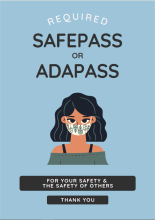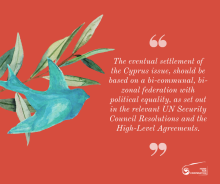Cyprus is a tiny island in the Mediterranean, which is divided in even tinier pieces. Nicosia, its capital, is the only divided capital in Europe after the collapse of the Berlin Wall. In-between this division lies the Home for Cooperation, an inter-communal hub dedicated to peace building, a building which has gone through decades of division to now stand as a bridge-builder, with its own story to tell. This is the story of how people of Cyprus came together to understand, to learn, to cooperate, to imagine, and to create together, in an unsuspected space. It is the story of how conserving a building of shared cultural heritage can provide the ground on which communities can build on, to collectively heal trauma and create new possibilities.
As the terminology becomes admittedly confusing, sometimes even for people born and raised in this complex context, let’s begin this story by mentioning some key words which will be mentioned throughout. “The divide or the division”: The division in Cyprus came as a result of the clashes between the Greek Cypriots and the Turkish Cypriots that were initiated and fuelled by extreme nationalist guerrilla organisations in both communities. The division line, came into existence in 1964 and took its current shape after the military intervention of Turkey in 1974. In 1975, Turkish Cypriots moved to north of the divide and Greek Cypriots, to south, as a result of the Population Exchange Agreement.
More useful to our story, however, is to introduce “the buffer zone”. This is a demilitarised strip of land that runs across the island from west to east for 180 km, dividing the island into north and south. At certain locations the buffer zone is some kilometres wide, and at others only a few steps. Now it seems to have acquired a somewhat contradictory quality. It has become an area of interaction.
In certain areas of the buffer zone, there are “checkpoints”, which are the entry or exit points to the areas controlled by one of the two communities. The Home for Cooperation is located in-between checkpoints in the heart of Nicosia, at the Ledra Palace crossing.
So how did this space come about? How can it be, that a building, in-between, became the embodiment of inter-communal cooperation, contributing to the collective efforts of civil society in their engagement with peace-building and intercultural dialogue?
Have you ever heard of the expression “if these walls could talk”? Well here, we’re giving them voice.
In the early 1950s, the building was constructed by the Mangoian family to be used as a home, and also host other businesses including a hair salon and a photography studio. They knew little that within the next decade, inter-communal clashes would leave traumatic marks on the street, the lives of the inhabitants and the building itself. With barricades marking the division of the island positioned on either of its sides, in 1964 the building was caught literally in between. Along with the barricades came a new presence in the area: the UN peace keeping forces. Movement from north to south along the street, and vice versa, was limited. In the summer of 1974, the building caught in between crossfire was dramatically marked. Then, it was left abandoned, to tell stories of confrontation and trauma.
In April 2003 the buffer zone became for the first time in over 30 years permeable. Of the few checkpoints to open, the Ledra Palace crossing was the first, with hundreds of people queuing in anticipation. A new dynamic was injected into communal and inter-communal life in the street. During this time, the Association for Historical Dialogue and Research, a group of scholars, researchers and teachers across the divide was already working on creating an open dialogue in historical understanding and enhanced research methods in Cyprus. In 2005 they came up with the idea of transforming this building into a shared space, an educational centre, and call it the “Home for Cooperation”. At the time, this idea seemed impossible even to the most passionate adherents of cooperation across the divide. Nevertheless, in 2007, UNFICYP granted support for an unprecedented civil society led effort to transform the buffer zone. And not long after, the AHDR received financial support from the European Economic Area Grants and Norway Grants (major donors Norway, Iceland and Liechtenstein) allowing the Home for Cooperation project to move ahead.
The conservation of this building to become an inter-communal research and education centre, extends beyond fixing damaged walls. As a site of shared cultural heritage for the people of Cyprus, it has shown that people who may have been separated for decades can come together, to understand, to learn, and to create together once again. And the transformation of this building has given the space to do just that.
The Home for Cooperation opened its doors to the world on the 6th of May 2011, with an opening ceremony bringing together the leaders of the Greek Cypriot and Turkish Cypriot communities, with representatives of civil society and dignitaries from around Europe, including the Council of Europe, Norway, Sweden, Switzerland and the Netherlands. The unique four-day celebration marking the inauguration of the Home showcased the collective efforts of civil society organisations across Cyprus, with musical performances, sports events, art exhibitions, a symposium and film screenings. Today the Home for Cooperation has organically grown from an educational and research centre, to a unique community centre infused with the identities, energies and ideas of people, of all people in Cyprus. Now this building has become a shared space where many narratives coexist. It exemplifies how the shared tangible and intangible heritage allow the people of Cyprus to come together. And it is now left to tell stories of healing and hope.
European Dimension
The Home for Cooperation is a space dedicated to facilitating contact between all communities in Cyprus and creating opportunities for collaboration on multiple levels, including musicians across the divide who share the same scene in one performance, to the general public who can attend guided city tours across the divide and create new experiences and memories with people they might have never met otherwise, and to local organizations that can meet and form partnerships. Through its workshops, classes, and events, the Home promotes cultural exchange of ideas, practices, knowledge and skills, in a safe space which fosters active participation by all people, in order to reclaim and redefine shared spaces such as the buffer zone. In recognition of its contribution to the discovery and preservation of a shared cultural heritage, in 2014 the Home for Cooperation was granted with the EU Prize for Cultural Heritage/Europa Nostra Award in the Conservation category.






